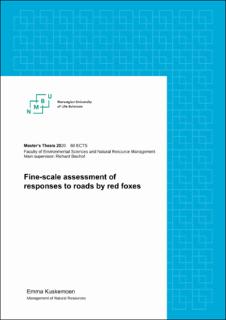| dc.contributor.advisor | Bischof, Richard | |
| dc.contributor.advisor | Thøger-Haaverstad, Karianne | |
| dc.contributor.author | Kuskemoen, Emma | |
| dc.coverage.spatial | Norway | en_US |
| dc.date.accessioned | 2021-01-02T15:35:44Z | |
| dc.date.available | 2021-01-02T15:35:44Z | |
| dc.date.issued | 2020 | |
| dc.identifier.uri | https://hdl.handle.net/11250/2721178 | |
| dc.description.abstract | Anthropogenic alterations are prevalent in most landscapes today, and roads have a distinct impact on the ecosystems they intersect and on the wildlife populations inhabiting them. Understanding and quantifying wildlife responses to roads can aid the development of effective management and mitigation strategies. Despite numerous studies on road impacts, few studies have looked at detailed behavioural responses and examined drivers of the activity at a fine spatiotemporal scale.
To address the knowledge gap of detailed behavioural responses to roads in fragmented landscapes, this study utilizes fine scale GPS data with high-frequency bursts generated by tracking 21 red foxes (Vulpes vulpes) in Norway. Four different behavioural responses to roads were identified and a mixed multinomial logit model was used to assess how landscape features, individual traits and the climate influenced the responses to roads.
Sex of the foxes and proximity to development were the variables which best explained the foxes’ probability to exhibit the recorded responses. Overall, the foxes were most likely to exhibit tracking, followed by crossing, being stationary and least likely to deflect when not near developed areas. When in proximity of development track became a less dominant behaviour, while the probability of being stationary increased. Additionally, great individual differences in road use between the foxes were observed.
The use of high-frequency bursts enabled me to identify and quantify detailed and short-lived behavioural responses to roads which would not be obtainable if the animals were tracked at a coarser spatiotemporal scale. This study has revealed that red foxes exhibit several behavioural responses to roads and utilize roads for movement. Additionally, the results suggest that roads near development are used mainly for forage and less for movement. This study highlights the need for high resolution tracking data when aiming to identify fine scale wildlife interaction with roads. | en_US |
| dc.description.abstract | Menneskeskapte endringer er i dag en dominerende del av de fleste landskap, og veier har stor påvirkningskraft på de økosystemene de fragmenterer. Kunnskap og kvantifisering av ville dyrs bruk av veier er et viktig verktøy for å utvikle effektive forvaltningsplaner og avbøtende tiltak. En rekke studier har undersøkt veiers effekt på ville dyr, men få har undersøkt i fin skala hvordan viltet beveger seg når de er i nærheten av vei og hvilke faktorer som påvirker bevegelsene.
På bakgrunn av dette er denne studien basert på høyfrekvens posisjonsdata der 21 rødrever (Vulpes vulpes) ble utstyrt med GPS halsbånd som samlet posisjoner med kort tidsintervall mellom. Fire typer adferdsmønster i nærheten av vei ble identifisert og en multinomisk logistisk regresjonsmodell ble brukt til å undersøke hvordan variasjoner i landskapet, individuelle forskjeller og klima påvirket de observerte bevegelsene. | en_US |
| dc.description.sponsorship | The Norwegian Public Road Administration/Statens vegvesen | en_US |
| dc.language.iso | eng | en_US |
| dc.publisher | Norwegian University of Life Sciences, Ås | en_US |
| dc.rights | Attribution-NonCommercial-NoDerivatives 4.0 Internasjonal | * |
| dc.rights.uri | http://creativecommons.org/licenses/by-nc-nd/4.0/deed.no | * |
| dc.subject | wildlife tracking | en_US |
| dc.subject | GPS telemetry | en_US |
| dc.subject | road use | en_US |
| dc.title | Fine-scale assessment of responses to roads by red foxes | en_US |
| dc.type | Master thesis | en_US |
| dc.source.pagenumber | 49 | en_US |
| dc.description.localcode | M-NF | en_US |

